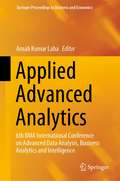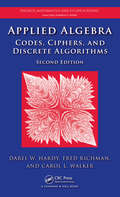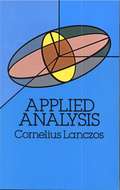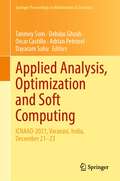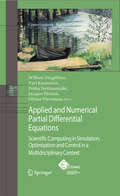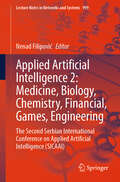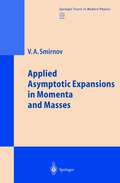- Table View
- List View
Applied Abstract Algebra (Undergraduate Texts in Mathematics)
by Rudolf Lidl Günter PilzThere is at present a growing body of opinion that in the decades ahead discrete mathematics (that is, "noncontinuous mathematics"), and therefore parts of applicable modern algebra, will be of increasing importance. Cer tainly, one reason for this opinion is the rapid development of computer science, and the use of discrete mathematics as one of its major tools. The purpose of this book is to convey to graduate students or to final-year undergraduate students the fact that the abstract algebra encountered pre viously in a first algebra course can be used in many areas of applied mathematics. It is often the case that students who have studied mathematics go into postgraduate work without any knowledge of the applicability of the structures they have studied in an algebra course. In recent years there have emerged courses and texts on discrete mathe matics and applied algebra. The present text is meant to add to what is available, by focusing on three subject areas. The contents of this book can be described as dealing with the following major themes: Applications of Boolean algebras (Chapters 1 and 2). Applications of finite fields (Chapters 3 to 5). Applications of semigroups (Chapters 6 and 7).
Applied Abstract Algebra (Undergraduate Texts in Mathematics)
by Rudolf Lidl Günter PilzAccessible to junior and senior undergraduate students, this survey contains many examples, solved exercises, sets of problems, and parts of abstract algebra of use in many other areas of discrete mathematics. Although this is a mathematics book, the authors have made great efforts to address the needs of users employing the techniques discussed. Fully worked out computational examples are backed by more than 500 exercises throughout the 40 sections. This new edition includes a new chapter on cryptology, and an enlarged chapter on applications of groups, while an extensive chapter has been added to survey other applications not included in the first edition. The book assumes knowledge of the material covered in a course on linear algebra and, preferably, a first course in (abstract) algebra covering the basics of groups, rings, and fields.
Applied Abstract Algebra with MapleTM and MATLAB: A Maple And Matlab Approach (Textbooks In Mathematics Ser.)
by Richard Klima Neil P. Sigmon Ernest StitzingerApplied Abstract Algebra with MapleTM and MATLAB provides an in-depth introduction to real-world abstract algebraic problems. This popular textbook covers a variety of topics including block designs, coding theory, cryptography, and counting techniques, including Polya's and Burnside's theorems. The book also includes a concise review of all prereq
Applied Abstract Algebra with MapleTM and MATLAB: A Maple And Matlab Approach
by Richard Klima Neil Sigmon Ernest StitzingerApplied Abstract Algebra with MapleTM and MATLAB provides an in-depth introduction to real-world abstract algebraic problems. This popular textbook covers a variety of topics including block designs, coding theory, cryptography, and counting techniques, including Polya's and Burnside's theorems. The book also includes a concise review of all prereq
Applied Advanced Analytics: 6th IIMA International Conference on Advanced Data Analysis, Business Analytics and Intelligence (Springer Proceedings in Business and Economics)
by Arnab Kumar LahaThis book covers several new areas in the growing field of analytics with some innovative applications in different business contexts, and consists of selected presentations at the 6th IIMA International Conference on Advanced Data Analysis, Business Analytics and Intelligence. The book is conceptually divided in seven parts. The first part gives expository briefs on some topics of current academic and practitioner interests, such as data streams, binary prediction and reliability shock models. In the second part, the contributions look at artificial intelligence applications with chapters related to explainable AI, personalized search and recommendation, and customer retention management. The third part deals with credit risk analytics, with chapters on optimization of credit limits and mitigation of agricultural lending risks. In its fourth part, the book explores analytics and data mining in the retail context. In the fifth part, the book presents some applications of analytics to operations management. This part has chapters related to improvement of furnace operations, forecasting food indices and analytics for improving student learning outcomes. The sixth part has contributions related to adaptive designs in clinical trials, stochastic comparisons of systems with heterogeneous components and stacking of models. The seventh and final part contains chapters related to finance and economics topics, such as role of infrastructure and taxation on economic growth of countries and connectedness of markets with heterogenous agents, The different themes ensure that the book would be of great value to practitioners, post-graduate students, research scholars and faculty teaching advanced business analytics courses.
The Applied Ai and Natural Language Processing Workshop: Explore Practical Ways to Transform Your Simple Projects into Powerful Intelligent Applications
by Krishna Sankar Jeffrey Jackovich Ruze RichardsAre you fascinated with applications like Alexa and Siri and how they accurately process information within seconds before returning accurate results? Are you looking for a practical guide that will teach you how to build intelligent applications that can revolutionize the world of artificial intelligence? The Applied AI and NLP Workshop will take you on a practical journey where you will learn how to build artificial intelligence (AI) and natural language processing (NLP) applications with Amazon Web services (AWS). Starting with an introduction to AI and machine learning, this book will explain how Amazon S3, or Amazon Simple Storage Service, works. You'll then integrate AI with AWS to build serverless services and use Amazon's NLP service Comprehend to perform text analysis on a document. As you advance, the book will help you get to grips with topic modeling to extract and analyze common themes on a set of documents with unknown topics. You'll also work with Amazon Lex to create and customize a chatbot for task automation and use Amazon Rekognition for detecting objects, scenes, and text in images. By the end of The Applied AI and NLP Workshop, you'll be equipped with the knowledge and skills needed to build scalable intelligent applications with AWS.
Applied Algebra: Codes, Ciphers and Discrete Algorithms, Second Edition (Discrete Mathematics And Its Applications Ser.)
by Darel W. Hardy Fred Richman Carol L. WalkerUsing mathematical tools from number theory and finite fields, Applied Algebra: Codes, Ciphers, and Discrete Algorithms, Second Edition presents practical methods for solving problems in data security and data integrity. It is designed for an applied algebra course for students who have had prior classes in abstract or linear algebra. While the con
Applied Algebra, Algebraic Algorithms and Error-Correcting Codes: 14th International Symposium, AAECC-14, Melbourne, Australia, November 26-30, 2001. Proceedings (Lecture Notes in Computer Science #2227)
by Serdar Boztas Igor E. ShparlinskiThe AAECC Symposia Series was started in 1983 by Alain Poli (Toulouse), who, together with R. Desq, D. Lazard, and P. Camion, organized the ?rst conference. Originally the acronym AAECC meant “Applied Algebra and Error-Correcting Codes”. Over the years its meaning has shifted to “Applied Algebra, Algebraic Algorithms, and Error-Correcting Codes”, re?ecting the growing importance of complexity in both decoding algorithms and computational algebra. AAECC aims to encourage cross-fertilization between algebraic methods and their applications in computing and communications. The algebraic orientation is towards ?nite ?elds, complexity, polynomials, and graphs. The applications orientation is towards both theoretical and practical error-correction coding, and, since AAECC 13 (Hawaii, 1999), towards cryptography. AAECC was the ?rst symposium with papers connecting Gr¨obner bases with E-C codes. The balance between theoretical and practical is intended to shift regularly; at AAECC-14 the focus was on the theoretical side. The main subjects covered were: – Codes: iterative decoding, decoding methods, block codes, code construction. – Codes and algebra: algebraic curves, Gr¨obner bases, and AG codes. – Algebra: rings and ?elds, polynomials. – Codes and combinatorics: graphs and matrices, designs, arithmetic. – Cryptography. – Computational algebra: algebraic algorithms. – Sequences for communications.
Applied Algebra, Algebraic Algorithms and Error-Correcting Codes: 15th International Symposium, AAECC-15, Toulouse, France, May 12-16, 2003, Proceedings (Lecture Notes in Computer Science #2643)
by Marc Fossorier Tom Hoeholdt Alain PoliApplied Algebra, Algebraic Algorithms and Error-Correcting Codes: 13th International Symposium, AAECC-13 Honolulu, Hawaii, USA, November 15-19, 1999 Proceedings (Lecture Notes in Computer Science #1719)
by Marc Fossorier Hideki Imai Shu Lin Alain PoliThis book constitutes the refereed proceedings of the 19th International Symposium on Applied Algebra, Algebraic Algorithms and Error-Correcting Codes, AAECC-13, held in Honolulu, Hawaii, USA in November 1999.The 42 revised full papers presented together with six invited survey papers were carefully reviewed and selected from a total of 86 submissions. The papers are organized in sections on codes and iterative decoding, arithmetic, graphs and matrices, block codes, rings and fields, decoding methods, code construction, algebraic curves, cryptography, codes and decoding, convolutional codes, designs, decoding of block codes, modulation and codes, Gröbner bases and AG codes, and polynomials.
Applied Analysis (Mathematics and Its Applications #31)
by A.M. KrallApproach your problems from the right end It isn't that they can't see the solution. It is and begin with the answers. Then one day, that they can't see the problem. perhaps you will find the final question. G. K. Chesterton. The Scandal of Father 'The Hermit Clad in Crane Feathers' in R. Brown 'The point of a Pin', van Gu!ik. 'g The Chinese Maze Murders. Growing specialization and diversification have brought a host of monographs and textbooks on increasingly specialized topics. However, the "tree" of knowledge of mathematics and related fields does not grow only by putting forth new branches. It also happens, quite often in fact, that branches which were thought to be completely disparate are suddenly seen to be related. Further, the kind and level of sophistication of mathematics applied in various sciences has changed drastically in recent years: measure theory is used (non-trivially) in regional and theoretical economics; algebraic geometry interacts with physics; the Minkowsky lemma. coding theory and the structure of water meet one another in packing and covering theory; quantum fields, crystal defects and mathematical programming profit from homotopy theory; Lie algebras are relevant to filtering; and prediction and electrical engineering can use Stein spaces. And in addition to this there are such new emerging subdisciplines as "experimental mathematics", "CFD", "completely integrable systems", "chaos, synergetics and large-scale order", which are almost impossible to fit into the existing classification schemes. They draw upon widely different sections of mathematics.
Applied Analysis: Prentice Hall Mathematics Series (Dover Books on Mathematics)
by Cornelius LanczosThis is a basic text for graduate and advanced undergraduate study in those areas of mathematical analysis that are of primary concern to the engineer and the physicist, most particularly analysis and design of finite processes that approximate the solution of an analytical problem. The work comprises seven chapters:Chapter I (Algebraic Equations) deals with the search for roots of algebraic equations encountered in vibration and flutter problems and in those of static and dynamic stability. Useful computing techniques are discussed, in particular the Bernoulli method and its ramifications.Chapter II (Matrices and Eigenvalue Problems) is devoted to a systematic development of the properties of matrices, especially in the context of industrial research.Chapter III (Large-Scale Linear Systems) discusses the "spectroscopic method" of finding the real eigenvalues of large matrices and the corresponding method of solving large-scale linear equations as well as an additional treatment of a perturbation problem and other topics.Chapter IV (Harmonic Analysis) deals primarily with the interpolation aspects of the Fourier series and its flexibility in representing empirically given equidistant data.Chapter V (Data Analysis) deals with the problem of reduction of data and of obtaining the first and even second derivatives of an empirically given function — constantly encountered in tracking problems in curve-fitting problems. Two methods of smoothing are discussed: smoothing in the small and smoothing in the large.Chapter VI (Quadrature Methods) surveys a variety of quadrature methods with particular emphasis on Gaussian quadrature and its use in solving boundary value problems and eignenvalue problems associated with ordinary differential equations.Chapter VII (Power Expansions) discusses the theory of orthogonal function systems, in particular the "Chebyshev polynomials."This unique work, perennially in demand, belongs in the library of every engineer, physicist, or scientist interested in the application of mathematical analysis to engineering, physical, and other practical problems.
Applied Analysis in Biological and Physical Sciences: ICMBAA, Aligarh, India, June 2015 (Springer Proceedings in Mathematics & Statistics #186)
by Jim M. Cushing M. Saleem H. M. Srivastava Mumtaz Ahmad Khan M. MerajuddinThe book contains recent developments and contemporary research in mathematical analysis and in its application to problems arising from the biological and physical sciences. The book is of interest to readers who wish to learn of new research in such topics as linear and nonlinear analysis, mathematical biology and ecology, dynamical systems, graph theory, variational analysis and inequalities, functional analysis, differential and difference equations, partial differential equations, approximation theory, and chaos.All papers were prepared by participants at the International Conference on Recent Advances in Mathematical Biology, Analysis and Applications (ICMBAA-2015) held during 4–6 June 2015 in Aligarh, India. A focal theme of the conference was the application of mathematics to the biological sciences and on current research in areas of theoretical mathematical analysis that can be used as sophisticated tools for the study of scientific problems. The conference provided researchers, academicians and engineers with a platform that encouraged them to exchange their innovative ideas in mathematical analysis and its applications as well as to form interdisciplinary collaborations.The content of the book is divided into three parts: Part I contains contributions from participants whose topics are related to nonlinear dynamics and its applications in biological sciences. Part II has contributions which concern topics on nonlinear analysis and its applications to a variety of problems in science, engineering and industry. Part III consists of contributions dealing with some problems in applied analysis.
Applied Analysis, Optimization and Soft Computing: ICNAAO-2021, Varanasi, India, December 21–23 (Springer Proceedings in Mathematics & Statistics #419)
by Tanmoy Som Debdas Ghosh Oscar Castillo Adrian Petrusel Dayaram SahuThis book contains select contributions presented at the International Conference on Nonlinear Applied Analysis and Optimization (ICNAAO-2021), held at the Department of Mathematics Sciences, Indian Institute of Technology (BHU) Varanasi, India, from 21–23 December 2021. The book discusses topics in the areas of nonlinear analysis, fixed point theory, dynamical systems, optimization, fractals, applications to differential/integral equations, signal and image processing, and soft computing, and exposes the young talents with the newer dimensions in these areas with their practical approaches and to tackle the real-life problems in engineering, medical and social sciences. Scientists from the U.S.A., Austria, France, Mexico, Romania, and India have contributed their research. All the submissions are peer reviewed by experts in their fields.
Applied Analytics through Case Studies Using SAS and R: Implementing Predictive Models and Machine Learning Techniques
by Deepti GuptaExamine business problems and use a practical analytical approach to solve them by implementing predictive models and machine learning techniques using SAS and the R analytical language. This book is ideal for those who are well-versed in writing code and have a basic understanding of statistics, but have limited experience in implementing predictive models and machine learning techniques for analyzing real world data. The most challenging part of solving industrial business problems is the practical and hands-on knowledge of building and deploying advanced predictive models and machine learning algorithms. Applied Analytics through Case Studies Using SAS and R is your answer to solving these business problems by sharpening your analytical skills. What You'll Learn Understand analytics and basic data concepts Use an analytical approach to solve Industrial business problems Build predictive model with machine learning techniquesCreate and apply analytical strategiesWho This Book Is ForData scientists, developers, statisticians, engineers, and research students with a great theoretical understanding of data and statistics who would like to enhance their skills by getting practical exposure in data modeling.
Applied and Computational Mathematics: ICoMPAC 2023, Sukolilo, Indonesia, September 30 (Springer Proceedings in Mathematics & Statistics #455)
by Dieky Adzkiya Kistosil FahimThis book collects selected, peer-reviewed research presented at the 8th International Conference on Mathematics: Pure, Applied, and Computation, held in Lombok, Indonesia, on 30 September 2023. Organised into three parts—Part I: Control Systems, Mathematical Simulation and Modeling; Part II: Formal Methods and Data Science; Part III: Graph Theory and Analysis—the book contains 29 peer-reviewed chapters. Ranging from theoretical to applied results, the book addresses the mathematical models for several phenomena such as investment behavior, unmanned surface vehicles and electronic medical records. It also highlights the progress in the use of satisfiability methods and tools to solve puzzle and pencil games. It showcases how mathematics is used to solve real-world problems.
Applied and Computational Matrix Analysis: MAT-TRIAD, Coimbra, Portugal, September 2015 Selected, Revised Contributions (Springer Proceedings in Mathematics & Statistics #192)
by Natália BebianoThis volume presents recent advances in the field of matrix analysis based on contributions at the MAT-TRIAD 2015 conference. Topics covered include interval linear algebra and computational complexity, Birkhoff polynomial basis, tensors, graphs, linear pencils, K-theory and statistic inference, showing the ubiquity of matrices in different mathematical areas.With a particular focus on matrix and operator theory, statistical models and computation, the International Conference on Matrix Analysis and its Applications 2015, held in Coimbra, Portugal, was the sixth in a series of conferences. Applied and Computational Matrix Analysis will appeal to graduate students and researchers in theoretical and applied mathematics, physics and engineering who are seeking an overview of recent problems and methods in matrix analysis.
Applied and Computational Optimal Control: A Control Parametrization Approach (Springer Optimization and Its Applications #171)
by Kok Lay Teo Bin Li Changjun Yu Volker RehbockThe aim of this book is to furnish the reader with a rigorous and detailed exposition of the concept of control parametrization and time scaling transformation. It presents computational solution techniques for a special class of constrained optimal control problems as well as applications to some practical examples. The book may be considered an extension of the 1991 monograph A Unified Computational Approach Optimal Control Problems, by K.L. Teo, C.J. Goh, and K.H. Wong. This publication discusses the development of new theory and computational methods for solving various optimal control problems numerically and in a unified fashion. To keep the book accessible and uniform, it includes those results developed by the authors, their students, and their past and present collaborators. A brief review of methods that are not covered in this exposition, is also included. Knowledge gained from this book may inspire advancement of new techniques to solve complex problems that arise in the future. This book is intended as reference for researchers in mathematics, engineering, and other sciences, graduate students and practitioners who apply optimal control methods in their work. It may be appropriate reading material for a graduate level seminar or as a text for a course in optimal control.
Applied and Industrial Mathematics: Venice - 1, 1989 (Mathematics and Its Applications #56)
by Renato SpiglerVenice-1 symposium on applied and industrial mathematics, 1989
Applied and Industrial Mathematics, Venice—2, 1998: Selected Papers from the ‘Venice—2/Symposium on Applied and Industrial Mathematics’, June 11–16, 1998, Venice, Italy
by Renato SpiglerIn this volume, I have collected several papers which were presented at the international conference called "Venice-2/Symposium on Applied and In dustrial Mathematics". Such a conference was held in Venice, Italy, between June 11 and 16,1998, and was intended as the follow-up of the very successful similar event (called "Venice-1/Symposium on Applied and Industrial Math ematics"), that was also organized in Venice in October 1989. The Venice-1 conference ended up with a Kluwer volume like this one. I am grateful to Kluwer for having accepted to publish the present volume, the aim of which is to update somehow the state-of-the-art in the field of Ap plied Mathematics as well as in that of the nowadays rather more developed area of Industrial Mathematics. The most of the invited (key-note) speakers contributed to this volume with a paper related to their talk. There are, in addition·, a few significant contributed papers, selected on the basis of their quality and relevance to the present-time research activities. The topics considered in the conference range from rather general sub jects in applied and numerical analysis, to more specialized subjects such as polymers and disordered media, granular flow, semiconductor mathematics, superconductors, elasticity, tomography and other inverse problems, financial modeling, photographic sciences, etc. The papers collected in this volume provide a selection of them. It is clear from the previous list that some attention has been paid to relatively new and emerging fields.
Applied and Numerical Partial Differential Equations: Scientific Computing in Simulation, Optimization and Control in a Multidisciplinary Context (Computational Methods in Applied Sciences #15)
by W. Fitzgibbon Y. A. Kuznetsov Pekka Neittaanmäki Jacques Périaux Olivier PironneauApplied Artificial Intelligence 2: The Second Serbian International Conference on Applied Artificial Intelligence (SICAAI) (Lecture Notes in Networks and Systems #999)
by Nenad FilipovićThe book Applied Artificial Intelligence 2: Medicine, Biology, Chemistry, Financial, Games, Engineering is providing exceptional chapters of the state-of-the-art research knowledge and results on the innovative theories, methodology and applications of artificial intelligence and its sub-domain like deep learning, machine learning in different areas such as medicine, economy, education, law, smart city, government, industry etc. Innovative research ideas on how to solve problems using artificial intelligence, both in R&D and real-time applications are presented. Chapters describe the advanced prototypes, systems, methodologies, tools and techniques and general survey papers, which indicate future directions. These Chapters are extended papers from the Second Serbian International Conference on Applied Artificial Intelligence (SICAAI), which was held in Kragujevac, Serbia, on May 19-20, 2023
Applied Asset and Risk Management: A Guide to Modern Portfolio Management and Behavior-Driven Markets (Management for Professionals)
by Marcus Schulmerich Yves-Michel Leporcher Ching-Hwa EuThis book is a guide to asset and risk management from a practical point of view. It is centered around two questions triggered by the global events on the stock markets since the middle of the last decade: - Why do crashes happen when in theory they should not? - How do investors deal with such crises in terms of their risk measurement and management and as a consequence, what are the implications for the chosen investment strategies? The book presents and discusses two different approaches to finance and investing, i.e., modern portfolio theory and behavioral finance, and provides an overview of stock market anomalies and historical crashes. It is intended to serve as a comprehensive introduction to asset and risk management for bachelor’s and master’s students in this field as well as for young professionals in the asset management industry. A key part of this book is the exercises to further demonstrate the concepts presented with examples and a step-by-step business case. An Excel file with the calculations and solutions for all 17 examples as well as all business case calculations can be downloaded at extras.springer.com.
Applied Asymptotic Expansions in Momenta and Masses (Springer Tracts in Modern Physics #177)
by Vladimir A. Smirnov'The sturgeon they sent was second grade fresh,' said the barman. 'Really, what nonsense/' 'Why nonsense?' '"Second grade fresh" that's what I call nonsense/ There's only one degree of freshness the first, and it's the last) (M. A. Bulgakov, The Master and Margarita) The goal of this book is to describe in detail how Feynman integrals can be expanded in suitable parameters, when various momenta or masses are small or large. In a narrow sense, this problem is connected with practical calcula tions. In a situation where a given Feynman integral depends on parameters of very different scales, a natural idea is to replace it by a sufficiently large number of terms of an expansion of it in ratios of small and large scales. It will be explained how this problem of expansion can be systematically solved, by formulating universal prescriptions that express terms of the expansion by using the original Feynman integral with its integrand expanded into a Taylor series in appropriate momenta and masses. It turns out that knowledge of the structure of the asymptotic expansion at the diagrammatic level is a key point in understanding how to perform expansions at the operator level. There are various examples of these ex pansions: the operator product expansion, the large mass expansion, Heavy Quark Effective Theory, Non Relativistic QCD, etc. Each of them serves as a realization of the factorization of contributions of different scales.
Applied Asymptotic Methods in Nonlinear Oscillations (Solid Mechanics and Its Applications #55)
by Yuri A. Mitropolsky Nguyen Van DaoMany dynamical systems are described by differential equations that can be separated into one part, containing linear terms with constant coefficients, and a second part, relatively small compared with the first, containing nonlinear terms. Such a system is said to be weakly nonlinear. The small terms rendering the system nonlinear are referred to as perturbations. A weakly nonlinear system is called quasi-linear and is governed by quasi-linear differential equations. We will be interested in systems that reduce to harmonic oscillators in the absence of perturbations. This book is devoted primarily to applied asymptotic methods in nonlinear oscillations which are associated with the names of N. M. Krylov, N. N. Bogoli ubov and Yu. A. Mitropolskii. The advantages of the present methods are their simplicity, especially for computing higher approximations, and their applicability to a large class of quasi-linear problems. In this book, we confine ourselves basi cally to the scheme proposed by Krylov, Bogoliubov as stated in the monographs [6,211. We use these methods, and also develop and improve them for solving new problems and new classes of nonlinear differential equations. Although these methods have many applications in Mechanics, Physics and Technique, we will illustrate them only with examples which clearly show their strength and which are themselves of great interest. A certain amount of more advanced material has also been included, making the book suitable for a senior elective or a beginning graduate course on nonlinear oscillations.



